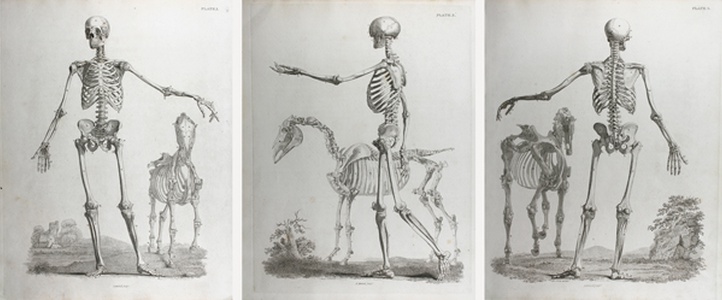| Method | Copper engraving |
| Artist | Edward Mitchell after Bernhard Siegfried Albinus and George Stubbs |
| Published | Edinburgh: Printed for MacLachlan and Stewart, and Baldwin, Cradock, and Joy London, 1824. |
| Dimensions | Image 250 x 190 mm, Sheet 295 x 230 mm each |
| Notes |
A trio of prints of illustrations of the human skeleton based on Bernhard Siegfried Albinus's earlier illustrations of 1749 accompanied by a rendering of a horse skeleton done after George Stubb's famous illustrations of horse anatomy of 1766. These prints are from John Barclay's A Series of Engravings of the Human Skeleton, MacLachlan and Stewart, Edinburgh, 1824. Edward Mitchell (fl. 1797-1845) was an Edinburgh engraver and occasional publisher. Bernhard Siegfried Albinus (1697-1770) was a German born Dutch anatomist. He is known for editing the works of Andreas Vesalius and William Harvey with Hermann Boerhaave but most well known for his lavishly illustrated Tabulae sceleti et musculorum corporis humani, which he first publsihed in Leiden in 1747. Albinus worked with the engraver Jan Wandelaar (1690-1759) and in an attempt to increase the scientific accuracy of anatomical illustration, Albinus and Wandelaar devised a new technique of placing nets with square webbing at specified intervals between the artist and the anatomical specimen and copying the images using the grid patterns George Stubbs (1724-1806) was a painter and anatomist. A superb animal painter and a penetrating portraitist, Stubbs is best known for his Anatomy of a Horse, 1766, a series of magnificent engravings based on the dissections he carried out in a remote village in Lincolnshire. A friend of Josiah Wedgwood, Stubbs experimented with painting on alternative surfaces, including copper, porcelain and a Wedgwood plaque. John Barclay FRSE FRCPE FRCSE FLS MWS (1758-1826) was a comparative anatomist and lecturer. Born in Cairn, Perthshire, Barclay initially studied theology at St. Andrew's and served served as a minister before going on to Edinburgh to study medicine Edinburgh. Barclay went on to study anatomy under Andrew Marshall in London before moving back to Edinburgh where he set himself up as an extramural lecturer in anatomy. His classes gradually grew in reputation and in 1804 he was formally recognised as a lecturer on anatomy and surgery by the Edinburgh College of Surgeons, and in 1806 he became a fellow of the Edinburgh College of Physicians. Condition: Trimmed close to plate on top and bottom margins, right margin of Plate 1, and left margin of Plate 2, as issued. |
| Framing | unmounted |
| Price | £350.00 |
| Stock ID | 50318 |

